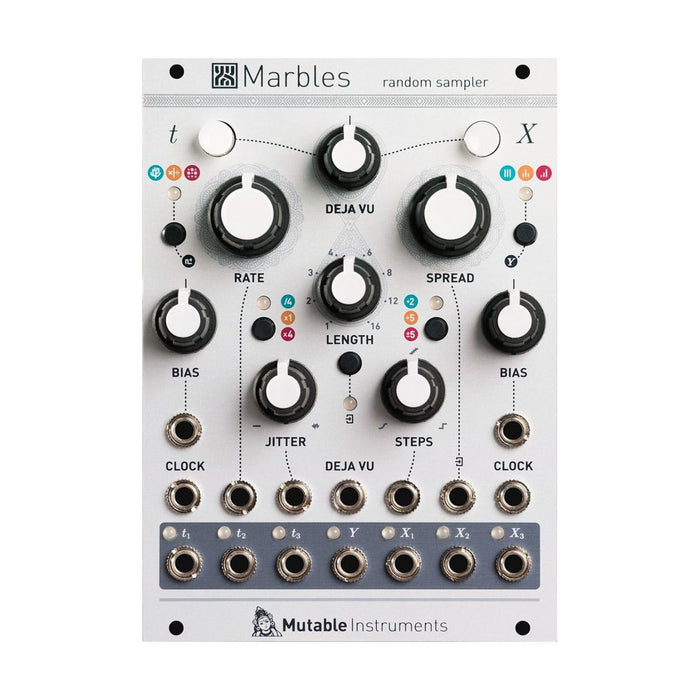Marbles is random gate, CV generator with large number of output and CV input. I can make a limit for the output random voltage in various forms (eg :)) such as the appearance degree of the same period with the outside clock, frequency of the repetition and the rare event, the traditional stepped random voltage.
t section: Random gate generator
I output a random gate sequence clock in the t section. I make the clock including the error and, based on a clock (divide) which this section makes an internal clock or an outside clock quick in an integral multiple and slowed , do it with a master. Do gap from the rhythm of a musician playing the error to hear a click, Rika bar from there; make a move, and can control the random that is complete from a 100% correct clock continually
JitterControl).
The algorithm of a gate output by t2 and t1 on the Rate knob left side. The master clock made in this way is output by t3.
t section mode choice buttonIn choice is possible and can choose it among the following
- ・ Algorithm to decide gate ON / OFF like a random coin tossBranchesAs well as). Bias introduces deflection into gate appearance probability from t1 and t3
- -Algorithm to perform random divide and multiplexing. Bias controls a divide and factor of multiplexing.
- ・ Algorithm to change the output of t1 and t3 by a kick and the pattern combination such as the snareGridsAs well as). Bias controls a pattern
The length of the gate
t section mode choice buttonI can control it by turning Bias in spite of being push. Again
t section mode choice buttonThe output gate head changes at random when I turn Jitter in spite of being push and can control the degree.
X section: Random CV generator
In this section, I output random CV which assumes the supporting t output (outside clock or common throughout an X section) a clock from X1 --X3. I can control the output random voltage by the following control variously. How do react to these control ; on the SPREAD right side?
X section mode change buttonNone of (X1 --X3 which finish appearing, and is substitute possibility panel control just what / X2 panel control just what, X1 and X3 setting / X3 of control and the truth reverse control just what, X1 setting of the truth reverse, X2 a knob setting) corresponding to the middle.
The probabilistic distribution shape of the voltage
spreadI control it in knob / CV. A knob is the left most, and the constant voltage is output, and the voltage is output according to the probability distribution that the voltage becomes the central peak when I turn it to the right. When a knob is a position of 12:00, and distribution becomes the bell shape and turns it to the right than it, the appearance probability of the value of the remote edge grows big from the center. A gate signal is output to come to output either minimum of the range or maximum when I finish turning it to the right. The center of the distribution of the X section
biasIt is controlled. The range is selectable from 0-2V, 0-5V, -5-5V with a range setting button.
The shape of the output voltage
STEPSControl is possible. STEPS is a position of 12:00, and the stepped random voltage only through normal sample & hold is output. The output voltage leave quantize when I turn it to the right, and only a route notebook (integer bolt) Is output at the end of the right. Only the notebook in a middle scale passes in the meantime, and the scale is setable by the push and hold of the voltage range button. Of the through to smooth off a stepped change when is located left STEPS than 12:00 it is to the voltage that took.
I can change the scale that is made quantize of the output voltage by pushing and holding a voltage range button for a few seconds for two seconds. After having pushed and held a button for a few seconds for two seconds, a color and blinking speed of the LED change when I push it several more times:
- Green slow blinking: Measure
- Bitter orange slow blinking: Minor
- Red slow blinking: Pentatonic
- Green is early and flashes on and off: Gamelan
- A bitter orange is early and flashes on and off: Raag Bhairav
- Red is early and flashes on and off: Raag Shree
I can change these scales. I input a gate into pace CV from a keyboard and a sequencer, X Section clock in Spread and push the outside processing mode button for two seconds. Marbles parses it when I input the musical scale that I want to use in the state and overwrites on a scale choosing now. It is with the musical scale that it is not rich, and is excluded that a thing with a little use frequency passes Steps to the right in the musical scale that I input most from the middle ..
I can use the X output as sample & hold of the outside input voltage not the random voltage. To this end, push the button under Length
Outside voltage use modeSpread CV input becomes the outside voltage performed sample & hold of then. I do movement not to change then with basically internal random voltage use, but the output of the sample & hold functions as X1 → X2 → X3 and moving shift register at every clock at this time when I patch outside clock because the output of X1 --X3 becomes same if the same.
Y section: Smooth random source
The Y output is the smooth random voltage of -5V -5V to change at a rate of 1/16 of X2. On the Spread right side
X section mode change buttonPush I change a parameter to support for the Y output when I turn a knob of Rate, Spread, Bias, Steps in spite of being
Deja Vu control
t section, the random nature of the X section,
Deja VuI can be affected by the control. I determine whether each section is affected by the Deja Vu control with the button of Deja Vu knob both sides. Deja Vu is control to mix loop-like structure with the output random voltage and random gate. for t section and the X section that Deja Vu was assigned, random characteristics disappear in the output by grinding Deja Vu knob midmost; the most recent data for designation step several minutes
LengthI play a loop as much as I appointed. The output changes from a loop in front at random gently when I pass Dejavu to the left, and a past random value and the random that there is not of the correlation come to appear at the left position. A thing picked up at random by the most recent data for the designated step is mixed and comes to be output when I turn it to the right from the middle.





